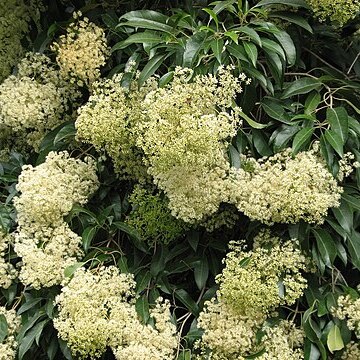Shrubs or small trees, glandular and ± hairy. Leaves petiolate; stipules reduced to a mere line. Flowers 4-merous, small and numerous, in cymose panicles. Calyx glandular, often externally; lobes valvate, persistent. Corolla-tube ± cylindrical, circumscissile just above the persistent base; lobes imbricate in aestivation. Stamens inserted just below mouth of corolla-tube, longly exserted; filaments filiform. Ovary 2-locular; ovules numerous in rows on axil placentas. Capsule ovoid or obloid, septicidally dehiscent and the valves halving above. Seeds small and numerous; endosperm fleshy; embryo straight.
Calyx campanulate to cylindrical, 4–lobed; lobes much shorter than the tube, triangular, acute or rarely obtuse or rounded, entire or sometimes tridenate (only observed in N. floribunda and N. gracilis), erect or suberect, sometimes two or two pairs coherent or partially united; flowers with almost regularly 4–lobed calyx or the irregularly lobed calyx in a single inflorescence, with minute glandular hairs and often also simple or branched hairs; inner side mostly sericeous to appressed–pubescent.
Stamens well exserted, inserted at the mouth of the corolla tube; filaments only at the very base vilose in a line with the group of hairs on the corolla throat or slightly above or entirely glabrous, straight or curved, geniculate at the base only in N. floribunda; anthers glabrous, 0–5–2 mm. long; cells 2, parallel when young, conspicuously divergent after the pollen has been shed, confluent at the apex, dehiscent throughout by a longitudinal slit.
Pistil: ovary superior, obcordoid, ovoid, or ellipsoid, mostly slightly laterally compressed, appressedly pubescent or hirto–pubescent, glabrous only in N. floribunda, at the very base, however, always glabrous, surrounded by a narrow disk–like ring formed by the base of the shed corolla, 2–celled; style well exserted, glabrous; stigma small, capitate or occasionally slightly bilobed.
Capsule about as long as and included in the persisting calyx or up to about one–third longer, with about the same indumentum as the ovary, bivalved, septicidal, retuse or rounded at the apex; often later longitudinally cleft, the capsule becoming 4–valved.
Leaves opposite, ternate, quaternate, or in some lateral branches occasionally alternate, petiolate (or only in N.gracilis often sessile).
Ultimate branches topped by solitary flowers or by heads of three or more flowers which may be globose.
In each cell one axile peltate placenta with many ovules attached to the middle of the septum.
Flowers 4–merous, actinomorphic except for the more or less irregularly lobed calyx.
Seeds small, medium brown, fusiform, longitudinally striate or reticulate–striate.
Inflorescence terminal, thyrsoid, but often dichotomously branched.
Lower bracts mostly leafy, the others small, often scale–like.
Branches unarmed, with fissured bark, not lenticellate.
Trunk often fluted.
Shrubs or trees.
